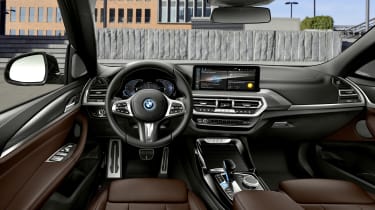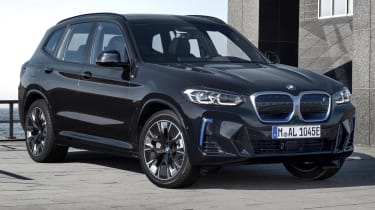New 2021 BMW iX3 electric SUV: prices, specs and on-sale date
BMW has given its iX3 electric SUV a facelift less than a year after it went on sale, with prices now starting from £60,970
BMW has updated the iX3 electric SUV with new styling and new trim levels, less than a year after this Audi Q4 e-tron rival arrived in showrooms. The exterior now more closely resembles the updated X3 petrol and diesel SUV, which also received a facelift earlier this year, while interior design and equipment remain the same.
In addition to the iX3’s styling, BMW has also altered the trim levels on offer: instead of Premier Edition and Premier Edition Pro, you now get a choice of either M Sport (£60,970) or M Sport Pro (£63,970).
The former has 19-inch aerodynamic wheels, heated electric sports seats and steering wheel, privacy glass and ambient lighting, in addition to an automatic bootlid, adaptive suspension and a panoramic sunroof. The iX3 runs BMW’s latest operating system on a 12.3-inch digital drivers display and 10.25-inch central infotainment screen.
M Sport Pro cars add a head-up display, a Harman Kardon stereo and gesture control for the infotainment. 'Parking Assistant Plus', automatic high beam, and keyless entry and start are also included. The M Sport Pro spec also boasts an external sound projector developed in collaboration with film-score composer Hans Zimmer – designed to alert pedestrians when the car is travelling at slow speeds.
BMW iX3 battery, range, charging and performance
The iX3 features the fifth generation of BMW’s eDrive electric powertrain technology. Its single electric motor develops 282bhp and 400Nm of torque, making the iX3 capable of accelerating from 0-62mph in 6.8 seconds and reaching an electronically limited top speed of 112mph. The iX3 is rear-wheel drive only, with no xDrive four-wheel-drive model announced as of yet.
However, the iX3 does boast an 80kWh battery (with 74kWh usable capacity), making it capable of up to 285 miles on a charge. It can charge at up to 150kW – faster than the Audi Q4 e-tron, but slower than a Hyundai Ioniq 5 or Kia EV6. Still, that's enough to get the batteries from 10% to 80% capacity in 34 minutes if you find a fast enough charging point. Charging from a regular 7.4kW home wallbox will take almost 12 hours.
The iX3 features three settings for its regenerative braking: high, medium or low. In addition, there’s a fourth ‘B’ setting, which engages “particularly strong recuperation” that BMW claims will allow “one-pedal” driving.
A further adaptive setup can use data from the sat nav and driver-assistance sensors to decide how much force to slow the car with. It can reduce the car’s speed for an upcoming junction, for example, or choose to engage the coasting function if the road ahead is clear.
Interior, technology and practicality
The inside of the new iX3 isn't all that different to the standard petrol and diesel X3, albeit with a few subtle changes to mark out the fully electric version. Most obvious are the blue accents that feature on the gearlever, steering wheel and start-stop button as well as on the exterior.
The new iX3 features the latest version of BMW’s infotainment operating system, which allows for over-the-air updates. Every model gets a 12.3-inch digital instrument cluster and a 10.25-inch central display. BMW Intelligent Personal Assistant allows for advanced voice recognition, while the iX3 will be offered not only with Apple CarPlay, but also Android Auto.
The tweaks to the BMW X3’s platform that underpins the iX3 and packaging result in a slightly smaller boot, and yet the iX3’s 510-litre load bay sizes up strongly against the petrol model’s 550-litre space. Overall capacity with the rear seats folded drops to 1,560 litres; only 40 litres less than in a conventional X3.
Design
While the iX3 is closely related to the conventional X3, the updated model has received some styling tweaks to bring it more in line with the other electric models in BMW’s range. Both the front and rear of the revised iX3 takes more influence from the i4 – BMW’s direct rival to the Tesla Model 3 – and its premium electric SUV, the iX.
The new iX3 retains its subtly sculpted body panels and a set of special aerodynamic wheels to aid efficiency – the latter reducing the car’s drag coefficient by around 5%. BMW says this adds up to six miles to the car’s officially calculated driving range. It also still uses an adapted version of the standard X3’s platform, with BMW positioning the batteries on the floor – lowering the SUV’s centre of gravity by 7.5cm.
Most Popular

EV Deal of the Day: Dacia Spring is amazingly good value at £116 per month






